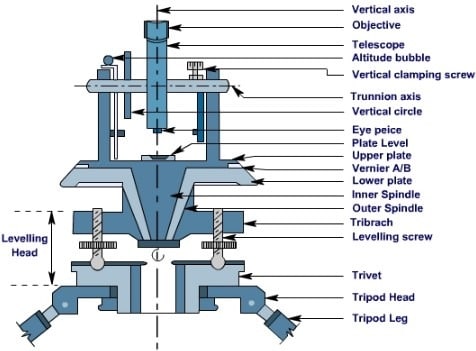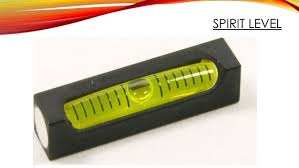Table of Contents
Theodolite:
In survey, a theodolite is an instrument mounted with a moveable telescope, used for precise measurements of horizontal and vertical angles. It can completely rotate along the horizontal plane and its telescope can be rotated up to 180°. It is considered to be more precise and speedy than the regular chain survey, compass or plane-table surveying and is commonly used in engineering fields for land surveying, route surveying and constructional surveys.
Classification of Theodolite
There are basically two classifications of theodolite;
1)Transit Theodolite:
If line of sight of the telescope can be reversed through the rotation of telescope by 180° about the trunnion axis in vertical plane, the theodolite is known as transit theodolite. This type of theodolite is commonly used for surveying.

2)Non-transit Theodolite:
If the telescope of a theodolite cannot be revolved about the trunnion axis, it is known as a non-transit theodolite. This type of theodolite is obsolete now.
Figure 2: Non-transit theodolite.
3)Vernier Theodolite:
Vernier theodolite is the type of theodolite in which the graduated circle is read with the help of Vernier.
4)Micrometer Theodolite:
Micrometer theodolite is that type of theodolite in which micrometer is provided for reading out graduated circle.
Important Terminologies
The following terms should be remembered while dealing with a transit theodolite;
1)Centering:
It is the process of setting theodolite exactly over the station using a plumb bob.
2)Transiting:
It means to bring the telescope upside down for pointing in opposite direction by 180° revolution of the telescope about horizontal axis in vertical plane. It is also known as plunging or reversing.
3)Swinging:
It is the process of rotating the telescope of the theodolite 180° about the vertical axis in horizontal plane.
4)Face Left:
While taking observations, if the vertical circle of the instrument is on left side of the observer, the instrument is said to face left and the readings taken in this position are known as face left readings.
5)Face Right:
Similarly, when the vertical circle is present on the right side of the observer, it is known as face right and the observations are termed as face right readings.
6)Face changing:
It is the process of transition of vertical circle from left to right or vice versa. It is done by completely transiting the telescope and then swinging the telescope.
7)Line of Collimation:
It is also termed as line of sight and is defined as an imaginary line joining the point of intersection of cross-hairs of the diaphragm and the optical centre of the object glass and its continuation.
Figure 3: Line of collimation
8)Axis of Telescope:
It is a line joining the optical center of the object glass and the center of the eye piece. It must be parallel to line of collimation.
Figure 4: Axis of Telescope
9)Axis of Level or Bubble Tube:
It is the straight line tangential to the longitudinal curve of the level tube at the center of the tube. It must be perpendicular to the vertical axis.
10)Vertical and Horizontal Axis:
The axis about which telescope rotates in horizontal plane is known as vertical axis while the axis about which the telescope rotates in vertical plane is known as horizontal axis. It is also called as trunnion axis.
Adjustment of Theodolite:
Following are the two types of adjustments of the theodolite;
1)Permanent Adjustment:
This type of adjustment is important for accurate observations and is made to establish relationship between the fundamental lines of a theodolite. These adjustments include;
- Adjusting horizontal plate levels
- Adjustment of collimation line
- Adjustments for horizontal axis
- Altitude level plate adjustment or adjustment of telescope level
- Adjustment of vertical circle
2)Temporary Adjustment:
This type of adjustments is made whenever the instrument is set before taking observations. It includes;
- Centering
- Leveling
- Focusing
Components of Theodolite:
It is important to know about all the parts of a theodolite and their functions in order to minimize errors during surveying. Figure 5 represents some of components of the theodolite.
Figure 5: Parts of Theodolite
Following is the brief description about components of a theodolite;
-
Telescope:
The telescope is the important part of the theodolite and is mounted directly on horizontal axis (Trunnion axis). It can rotate about horizontal axis in vertical plane and is used for viewing objects.
Figure 6: Diagram of Telescope of a Theodolite
-
Trunnion Axis:
Trunnion axis is the horizontal axis of the theodolite about which telescope rotates.
Figure 7: Trunnion Axis
-
Vernier Frame:
The Vernier frame comprises of two arms; vertical arm and horizontal arm. The vertical arm enables locking the telescope at desired level whereas, the horizontal arm is useful in measuring vertical angles.
-
Vertical Circle:
Vernier circle is a graduated circle rigidly fixed to the Trunnion axis of the telescope and is used for measuring vertical angles.
-
Plate Levels:
Plate levels are carried by the upper plate and enable the telescope to settle in an exact vertical position.
-
Standards:
The standards resemble the letter ‘A’ and are therefore also known as A-frame. They are used for supporting the telescope and allow its rotation about vertical axis.
-
Upper Plate (Vernier Plate):
Upper plate is connected to the inner axis and supports the standards. It is also used for regular rotation of telescope and standards for correct measurements.
-
Upper Clamp Screw:
Upper clamp screw is carried by the upper plate along with an upper tangent screw. It is used for tightening the upper plate to the lower plate.
-
Lower Plate (Scale Plate):
Lower plate or scale plate is the base of the entire instrument, connected tightly to the tripod assembly. It is used for measuring horizontal angles.
-
Lower Clamp Screw:
The lower clamp screw is attached to the lower plate along with a lower tangent screw. This screw is used for tightly fixing the lower plate to the upper tribrach plate.
-
Tripod:
A tripod is a solid of framed stand, equipped with steel shoes for firm grip on the ground. It is used for mounting the theodolite.
-
Plumb Bob:
At the very bottom of the inner axis, there is a hook used for suspending the plumb bob. The purpose of plumb bob is to precisely center the instrument over the marked station.
-
Leveling Head:
The leveling head is divided into two parallel triangular plates; upper tribrach plate and lower tribrach plate. The upper tribrach plate is used to level upper plate and telescope while the lower tribrach plate is used connecting theodolite to the tripod.
-
Clip Screw:
The clip screw is fitted at the lower end of the clipping arm for slightly rotating the index arm for adjustments. It is also used for centering the bubble of altitude level tube.
-
Altitude Level Tube:
Altitude level tube is fitted over the telescope and is helpful in testing whether the Trunnion axis is horizontal or not.
-
Compass:
Compass is attached to the A-frame of the theodolite and is helpful in taking bearings.
-
Shifting Head:
The shifting head lies below the lower plate and is used for centralizing the complete instrument over the benchmark position.
-
Two Spindles or Axes:
The spindles or axes are divided into internal spindle and outer spindle. The internal spindle/axis is solid and conical whereas the outer spindle is hollow. Both the axes form the vertical axis of the instrument.
-
Tangent Screw:
Along with the clamping screws of upper and lower plates are attached tangent screws, used for the fine movements of the plates.
-
Foot Screw:
The foot screws are conversed in trivet by ball-and-socket arrangement and are used for leveling the instrument.
-
Tribrach:
Tribrach is the bottom most assembly of the theodolite screwed on top of the tripod.
-
Spirit Level:
Spirit Level, also known as bubble level, is designed to specify whether the surface of theodolite is horizontal or vertical.
Figure 8: Spirit Level
Purpose of Theodolite Surveying:
Theodolite Surveying is carried out for many purposes, some of which are stated below;
- To measure horizontal and vertical angles precisely.
- To determine the difference in elevation of two points or to measure the height of a building/tower or depth of a valley.
- To measure distance between two points.
- For alignment of roads, railways, bridges, etc.
- For extending survey lines or survey works for mining.
- For measuring deflection angles between 2 points or to measure slopes.
- For laying out curves or to prepare topographic maps.
- It is also used in tachometric surveying and triangulation.












